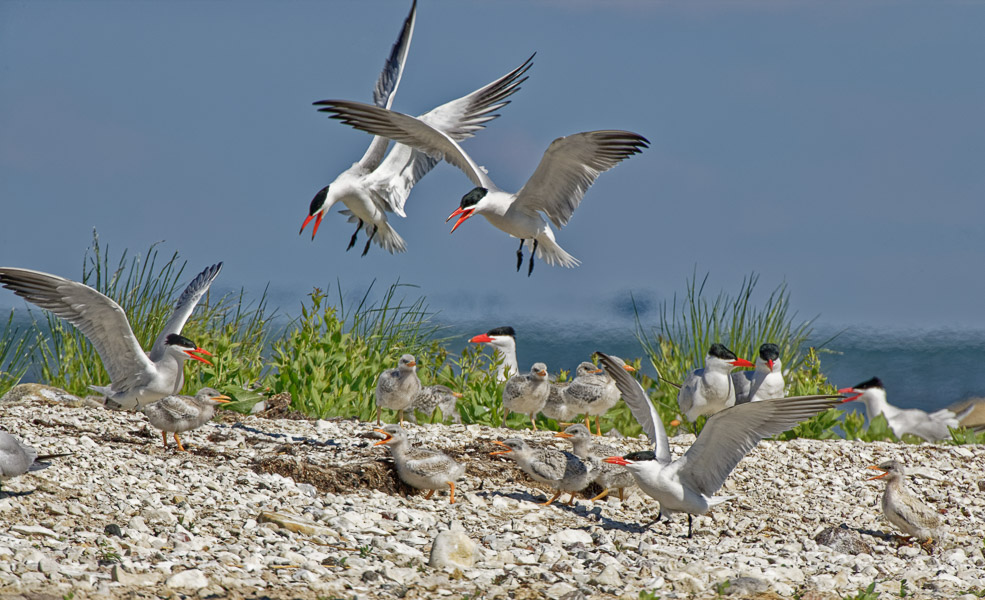Caspian tern
- Caspian tern
- https://linnuriik.ee/wp-content/uploads/2021/09/Rausktiirud_Arne-Ader.jpg
- Keemu linnud
- https://linnuriik.ee/wp-content/uploads/2021/09/rausk_salvestusVRunnel.mp3
Caspian terns. Photo: Arne Ader
Introduction
Latin Hydroprogne caspia
Estonian Räusktiir
Also known as: no known names
Status in Estonia
Breeding and migratory bird.
Description
This is the largest tern, with a wingspan longer than that of the common gull. The beak of the adult is very stout and bright red; most have a dark spot on front of the tip, while the primary feathers are dark in all plumages. The legs are black with a dark head and a face mask.
Size
Body length 48–55 cm, wingspan 96–111 cm, body mass 570–780g.
Similar species
Arctic tern, common tern.
Distribution
It is cosmopolitan, with the exception of South America and Antarctica as breeding grounds. The area is divided into 13 populations. The largest populations are found on the west coast of North America, around the Great Lakes, in West Africa and around the Caspian Sea. There are two breeding populations in Europe: around the Black Sea and the northern coastal areas of the Baltic Sea. In the autumn, the Baltic population migrates from Eastern and Central Europe to the Mediterranean, crossing the Sahara and settling in the middle course of the Niger River in West Africa. It is an uncommon breeding bird in Estonia.
Population
Estonia has 200–300 breeding pairs.
Occurrence in Estonia
It arrives in Estonia in April then departs like other terns shortly after nesting at the end of July. Most leave by the end of August. Birds that fail to breed may leave earlier.
Diet
Almost exclusively fish is on the table for this bird. It also rarely eats crustaceans and the eggs and chicks of other birds. It also steals prey from other seabirds.
Habitat
It has only bred in Western Estonia on grassy or stony islets. There must be decent fishing areas within a few dozen kilometres of the colony, typically at river mouths or bays.
Nesting
The Caspian tern is a monogamous bird. During courtship, the male bird brings fish to the female bird and performs a sophisticated courtship flight. The majority of Caspian terns (90%) nest in big colonies, with the remainder forming flocks of 1–2 pairs with other gulls. The nest is a hollow and can be lined with some straw or stones. In May through June, the female bird lays 2–3 eggs; incubation lasts 20–22 days and both adult birds participate. When the chicks hatch, their plumage varies from brood to brood, which is thought to help parents recognise their young when they return from hunting. The chicks learn to fly at 35–45 days old, but their parents continue to feed them for another seven months.
Conservation status and protection
It belongs to the protected species of category II. Disturbance or bad weather can potentially destroy 50% of Estonia’s nests in a short period of time. The harvesting of bird eggs, which is still practiced in several maritime regions of Estonia, is also a concern. Overgrowth of breeding islands is also a negative factor.
Distribution and population in Lääne County
The Caspian tern is an uncommon breeding and migratory bird found along the coast of Lääne County and on small sea islands. In Matsalu National Park, you can often see the Caspian tern in Haeska or Cape Puise. They can often be seen flying over Haapsalu as well as Saunja and Tahu bays.
Caspian terns nest in small colonies along the shores of the Väinameri region.
